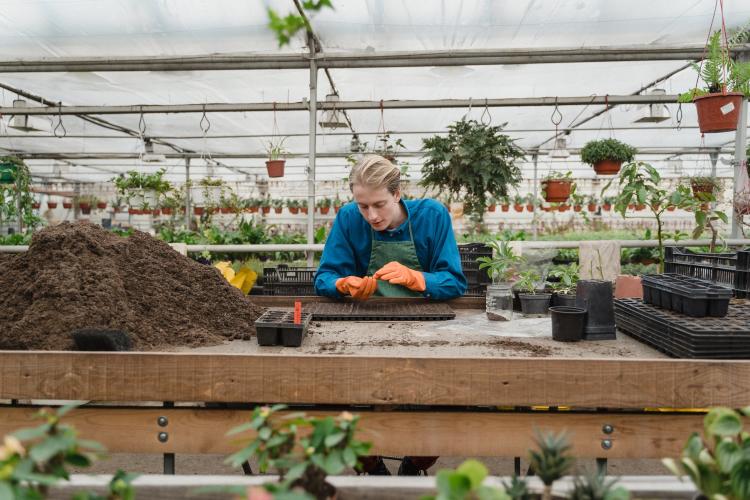
Have you already tried making compost at home and failed? Well, let me tell you that as happens in the kitchen there are certain rules to follow so that you can achieve the perfect compost. But which are these rules? Let me introduce to you The Perfect Compost Ratio: Greens to Brown Balance. A balance between greens and browns that will save your life (or your sustainable soul at least). Continue reading the article to discover the secrets.
The compost ratio is the desired balance between carbon-rich ingredients and nitrogen-rich ingredients. I know that at this moment you may be thinking: but what does science have to do with compost? Everything. Compost piles require four elements to fully work: carbon, nitrogen, oxygen and water. Let´s first explain some terms.
Carbon-rich ingredients represent the browns in a compost pile, whereas the nitrogen-rich ingredients represent the greens. As a reminder, typical browns are dried leaves, cardboard and paper, straw and some more. While typical greens include fresh leaves, vegetable and fruit scraps, flowers, eggshells, etc. Each of those ingredients has a specific amount of carbon and nitrogen. For example, coffee grounds are 20:1.
If you want more information about this, check the following article: How to make a Compost Pile? All you need to know about it
Scientists asserted that the key to achieve a sweet-smelling compost is to keep a carbon to nitrogen ratio of about 25/30 parts of carbon to 1 part of nitrogen (25/30:1). The reason for this is that the microbes involved in the composting process decompose the organic matter of the compost pile. To do such a process, they nurture themselves from carbon and use nitrogen to build their cell structure.
The above mentioned “growth” of microbes results in a fast and successful composting process and also the compost pile arrives to suitable temperatures. When this compost ratio is lower than the standard, you may experience issues with your compost, such as ammonia odor due to an excessive amount of nitrogen or greens.
When it is higher than the standard, the compost will seem dry due to an excess of carbon or browns. Arriving at the ideal ratio will accelerate the decomposition process enormously.
However, we know that the majority of people don't have the time to stop before composting to analyze which organic material represents carbon or nitrogen. That is why we will try to simplify your life.

It is important to mention that the carbon: nitrogen ratio and the compost ratio of green to brown are not the same. As we mentioned before, at your home you will be able to count buckets of browns and greens instead of atoms and molecules. Greens will help you enlarge nitrogen concentration and browns will help you reduce that concentration.
After all this knowledge you may wonder, but how can I know the C:N ratio of the materials? Luckily, each material has its corresponding C:N ratio. Read the list of greens and browns appearing below to excel at your compost ratio of green to brown.
| GREEN (NITROGEN) | |
|---|---|
| Food scraps | 17:1 |
| Vegetable scraps | 25:1 |
| Aged chicken manure | 7:1 |
| Coffee grounds | 25:1 |
| Grass clippings- Fresh | 17:1 |
| Fruit wastes | 25-40:1 |
| Weed | 30:1 |
| Garden waste | 30:1 |
| Seaweed | 19:1 |
| Fresh weeds | 20:1 |
| Farm manure | 90:1 |
| BROWN (CARBON) | |
|---|---|
| Straw, Hay | 90:1 |
| Leaves | 60:1 |
| Sawdust | 500:1 |
| Wood chips | 400:1 |
| Nut shells | 35:1 |
| Shredded newspaper | 175:1 |
| Pine needles | 80:1 |
| Corn stalks | 60:1 |
| Grain hulls | 80:1 |
| Shredded cardboard | 350:1 |
When you add two parts of a green material to one part of a brown material to your pile you will achieve the C: N compost ratio. But how can you calculate it? A part of a material is simply a certain quantity of it. The calculation you can do is summing up the carbon side ratio of the materials you have, then divide that result by the number of materials.
The resulting number will reveal the truth. Based on that number, you will decide whether to add more greens/nitrogen or add more browns/carbon.
Let's imagine that I have vegetable scraps, aged chicken manure and leaves as materials for my compost. The sum will be 25,7,60 and divide by the material´s quantity, i.e.: 92/3 equals 30:1.
As the ecologist lover that you are, I am sure you know some of the benefits of compost. The organic matter decomposed through that process can be used as a fertilizer and soil amendment. You can put that natural fertilizer on your garden and your plants will grow faster and stronger. It is better than using chemical fertilizers and it is also cheaper. Apart from that, you can reduce the garbage at your house at huuuge levels. Statistics show that food scraps and yard waste equal more than 30% of the garbage that we keep at home! Composting boosts the creation of humus, which results from the decomposed organic matter. Also, your waste remains in your garden in a different form instead of going to the landfills. There, garbage releases methane that affects the ozone layer.
By composting you can get the best of both worlds: help the environment and improve the quality of your soil and plants.

When you get to achieve the compost ratio of green to brown in your compost pile, the results will be seen immediately.
In hot composting the C:N ratio is super important. High C:N ratios will result in a stinky and ammonia odor compost. That doesn´t occur in cold piles since the off gassing of nitro only takes place under thermophilic conditions. Not only will the compost ratio of green to brown accelerate the composting but it will also help the pile to reach a hot temperature.
Since they allow the entrance of oxygen into your compost pile. The oxygen will help the microorganism’s growth and the results will be seen in a short time.
Materials as browns (carbon) and in wet materials as greens (nitrogen). Green material is usually found in your garden or at your household, while browns are more difficult to obtain. Picturing those concepts in your head will make everything easier.
Check the following list: What Can Be Composted? A Complete List of Things You Can Compost
Woody materials and chips are hard materials to break easily, they spend more time decomposing. That is why it is better to replace them with fallen leaves for example and leave those materials for another activity.

You better burn them.
One excellent advice is to train your smell to have a perfect compost balance. Whenever you smell something similar to rotten eggs means that you need to make a change. Add more greens and you will witness the miracle in a few days.
Such as sour cream and eggs. They cause disgusting odor and bring rats to your compost.
Be also sure to avoid these items: What Items Cannot Be Composted
If you think that something is wrong with your compost pile, check these hints:
If your compost smells like putrid food then you need to revise the nitrogen materials added to your pile. Probably there is an excess of them so you will need to counteract the effect by adding carbon materials (browns).

The microorganisms of your compost pile need the right amount of water and air to grow. If the pile is soggy it won't be able to provide the organisms a good living space. Instead, anaerobic bacteria will take their place. What are anaerobic bacteria? They do not need oxygen to survive since they don´t live or grow when there is oxygen present. They end up slowing the process of composting and produce a smell in your compost. More info here: Compost Too Wet? Reasons Why and Tips to Fix a Soggy Compost
Despite excess water isn't good for your compost ratio of green to brown, neither is a little amount of water. The right amount of water will result in a faster decomposition of organic materials; hence you will obtain results more quickly. You can notice the lack of water by revising the compost pile. So, if this is your case, check this post: What can you do if your compost is too dry?
Although it may seem difficult to have a great compost ratio, it is easier than you think. I encourage you to take into account all the advice given in the article and process the information calmly. Trust your gut on the process!
And if you were doing all of this, you may be wonder: When should I turn my compost pile? All you need to know about it